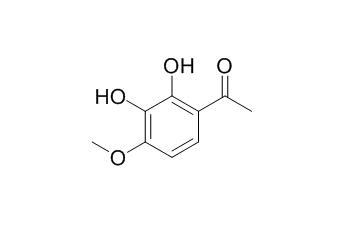2',3'-Dihydroxy-4'-methoxyacetophenone
2,3-Dihydroxy-4-methoxyacetophenone improves cognitive function and may be helpful for the treatment of Alzheimer's disease.
Inquire / Order:
manager@chemfaces.com
Technical Inquiries:
service@chemfaces.com
Tel:
+86-27-84237783
Fax:
+86-27-84254680
Address:
1 Building, No. 83, CheCheng Rd., Wuhan Economic and Technological Development Zone, Wuhan, Hubei 430056, PRC
Providing storage is as stated on the product vial and the vial is kept tightly sealed, the product can be stored for up to
24 months(2-8C).
Wherever possible, you should prepare and use solutions on the same day. However, if you need to make up stock solutions in advance, we recommend that you store the solution as aliquots in tightly sealed vials at -20C. Generally, these will be useable for up to two weeks. Before use, and prior to opening the vial we recommend that you allow your product to equilibrate to room temperature for at least 1 hour.
Need more advice on solubility, usage and handling? Please email to: service@chemfaces.com
The packaging of the product may have turned upside down during transportation, resulting in the natural compounds adhering to the neck or cap of the vial. take the vial out of its packaging and gently shake to let the compounds fall to the bottom of the vial. for liquid products, centrifuge at 200-500 RPM to gather the liquid at the bottom of the vial. try to avoid loss or contamination during handling.
Synthetic and Systems Biotechnology2023, j.synbio.
Int J Mol Sci.2020, 21(22):8816.
BMC Plant Biol.2020, 20(1):214.
PLoS One.2018, 13(4):e0195642
Korean J Pain.2021, 34(4):405-416.
Molecules.2021, 26(2):313.
Int J Food Sci Nutr.2019, 70(7):825-833
Int J Mol Sci.2024, 25(18):9909.
Curr Res Virol Sci.2022, 3:100019.
Molecules2020, 25(4):892
Related and Featured Products
Bioorg Med Chem Lett. 2013 Dec 15;23(24):6732-6.
The ameliorating effects of 2,3-dihydroxy-4-methoxyacetophenone on scopolamine-induced memory impairment in mice and its neuroprotective activity.[Pubmed:
24210692]
We isolated 2,3-dihydroxy-4-methoxyacetophenone, a neuroprotective compound from Cynenchum paniculatum in our previous study.
METHODS AND RESULTS:
The present study was conducted to investigate the possible neuroprotective effect of 2,3-dihydroxy-4-methoxyacetophenone that has been previously isolated from Cynenchum paniculatum on hippocampal neuronal cell line, HT22 cells and its possible cognitive-enhancing effect on scopolamine-induced amnesia in mice. Neuroprotective effect against glutamate-induced neurotoxicity in HT22 cells was evaluated by MTT assay. Also, cognitive enhancing effect against scopolamine (1mg/kg, ip) induced learning and memory deficit was measured by Morris water maze test. Oral administered of 2,3-dihydroxy-4-methoxyacetophenone (1, 10, 20, 40 and 50mg/kg) to amnesic mice induced by scopolamine. In Morris water maze test, 2,3-dihydroxy-4-methoxyacetophenone (50mg/kg) improved the impairment of spatial memory induced by scopolamine. 2,3-Dihydroxy-4-methoxyacetophenone protect HT22 cells on glutamate induced cell-death in a dose-dependent manner (EC50 value: 10.94μM). Furthermore, 2,3-dihydroxy-4-methoxyacetophenone was found to inhibit [Ca(2+)] accumulation in HT22 cells and had antioxidantive activity. The results showed that 2,3-dihydroxy-4-methoxyacetophenone exert neuroprotective and cognitive-enhancing activities through its antioxidant activity.
CONCLUSIONS:
We suggest that 2,3-dihydroxy-4-methoxyacetophenone improves cognitive function and may be helpful for the treatment of Alzheimer's disease.
Planta Medica, 2012, 78(5):71.
2,3-dihydroxy-4-methoxyacetophenone Isolated from Cynanchum paniculatum Attenuates Scopolamine-induced Impairment of Spatial Memory in Mice.[Reference:
WebLink]
METHODS AND RESULTS:
We isolated 2,3-dihydroxy-4-methoxyacetophenone(2',3'-Dihydroxy-4'-methoxyacetophenone) from Cynenchum paniculatum which we have previously reported as having an neuroprotective effect. The objective of this study was to investigate the cognitive-enhancing effect of 2,3-dihydroxy-4-methoxyacetophenone on scopolamine-induced amnesia. SCOP (1 mg/kg, i.p.) induced a learning and memory deficit measured both during and after training 2,3-dihydroxy-4-methoxyacetophenone was orally administered to amnesic mice induced by scopolamine and the mice were then evaluated using the Morris water maze test. The results showed that 2,3-dihydroxy-4-methoxyacetophenone ameliorated scopolamine- induced amnesia based on the Morris water maze test.
CONCLUSIONS:
We suggest that 2,3-dihydroxy-4-methoxyacetophenone improve cognitive function and may be helpful for the treatment of Alzheimer's disease.



